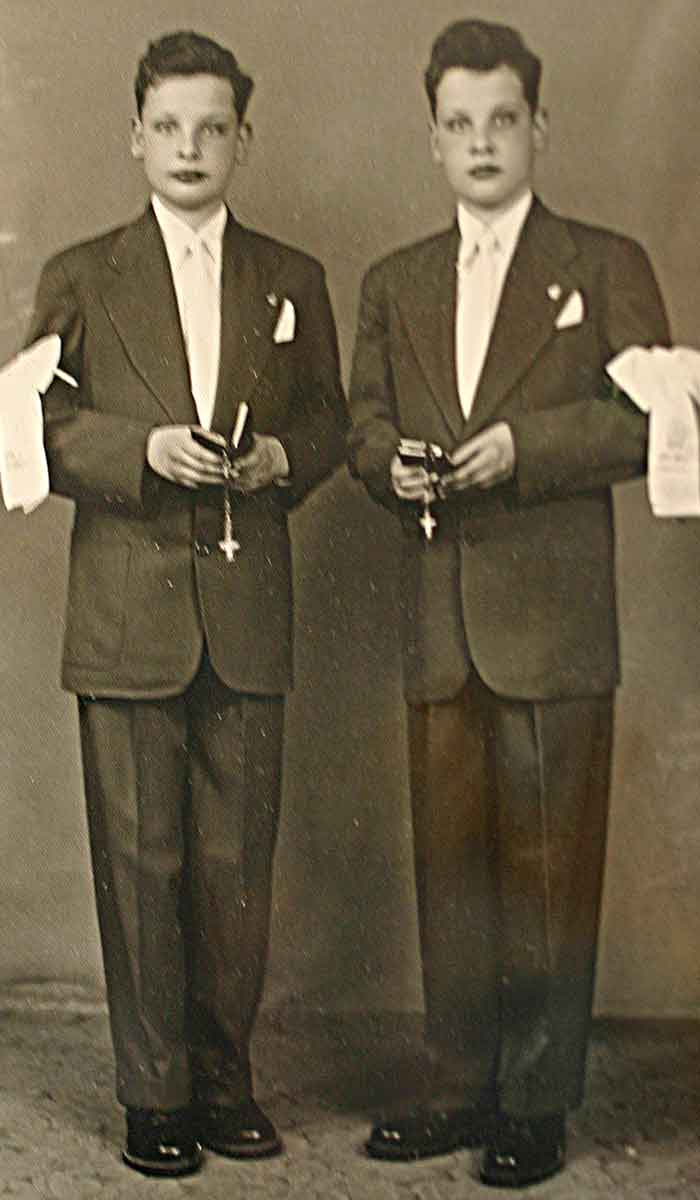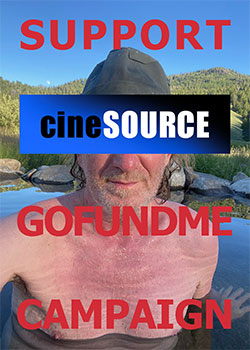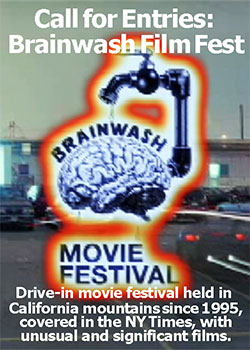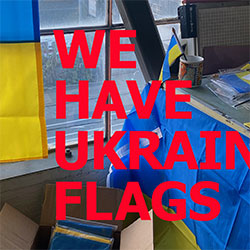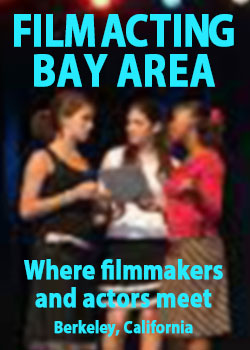Alt Narrative: Up from the Underground with the Kuchar Twins
by Roger Rose
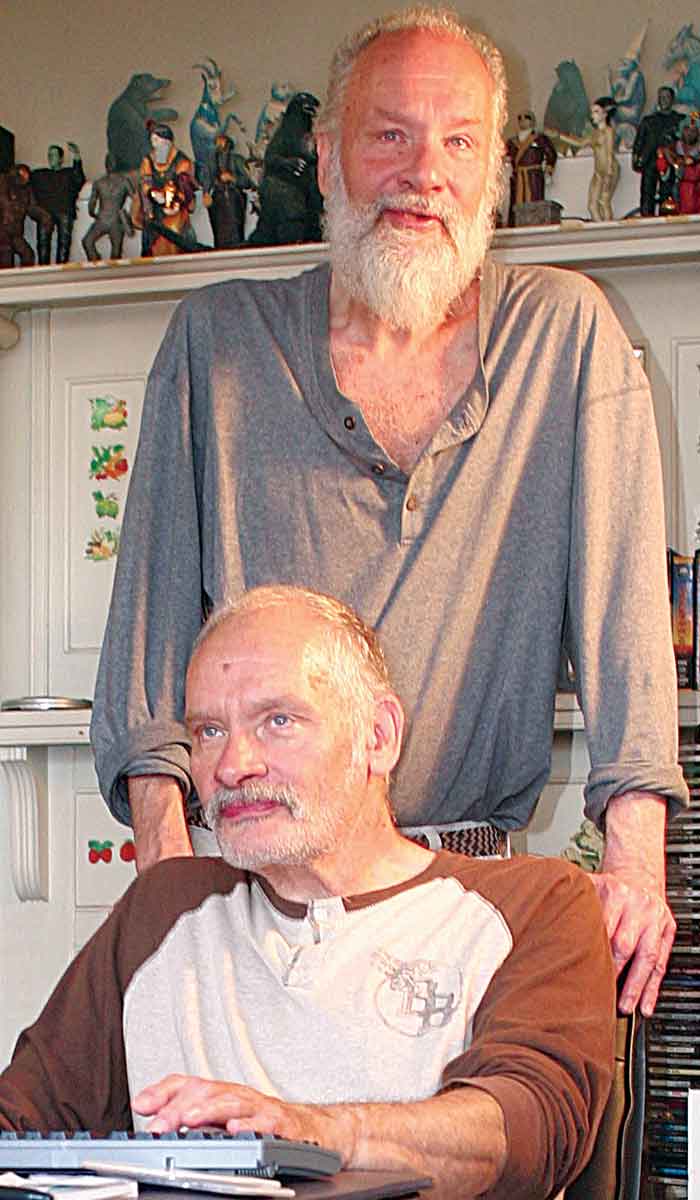 The Kuchar Brothers at work in their crowded but not cluttered Mission neighborhood apartment. photo CineSourceAfter years of laboring in semi-obscurity to the commercial film world, George and Mike Kuchar are finally getting some recognition. With a cult legacy of zany high camp and an artistic obsession for homemade special effects, the "8mm Mozarts" have helped to shape the New York underground film scene alongside the then-emerging iconoclast Andy Warhol.
The Kuchar Brothers at work in their crowded but not cluttered Mission neighborhood apartment. photo CineSourceAfter years of laboring in semi-obscurity to the commercial film world, George and Mike Kuchar are finally getting some recognition. With a cult legacy of zany high camp and an artistic obsession for homemade special effects, the "8mm Mozarts" have helped to shape the New York underground film scene alongside the then-emerging iconoclast Andy Warhol.
As the subjects of Jennifer Kroot's new feature documentary, "It Came From Kuchar," which opened at Frameline 33 here last month, the brothers are getting exposed to a much wider audience. Kroot is a former student of George Kuchar at the San Francisco Art Institute, where he still teaches, and which brought him to the Bay Area from the Bronx in 1971. Kroot knew from the very first day of class that she wanted to do a documentary on the legendary indie brothers. "As I got to know him and his brother, it kept unfolding in more interesting and strange ways. Eventually I just had to do it," she remarks.
The list of filmmakers citing the Kuchar brothers as influences continues on and on. From Wayne Wang to B. Ruby Rich and Atom Etoyan, generations of cineastes continue to borrow from their original style. "People see all of these filmmakers associated with them," said Kroot. "I think it's fair to say that they inspired John Waters to pick up a camera. Their style of filmmaking—using friends as actors, just having a good time with it—became essential to his work." Moreover, they focused on alternative narratives at a time when everyone was going visual and abstract.
The Kuchars established themselves as a part of the freethinking bohemian community in New York with George's "I Was a Teenage Rumpot" (1960), which made great use of what would become their infamous brand of homemade special effects. Their work slowly became known to artists, hitting a flash with a 1967 article in Playboy, in which writers Knight and Albert commented that, "the Kuchars take neither themselves nor their movies too seriously. For the most part the Underground is a dreadfully intense bunch of people."
Beginning with "The Secret of Wendel Samson," Mike's films became socially relevant as openly sexual portrayals of the then-taboo gay lifestyle. In this film, avant-garde artist Red Grooms played a conflicted young man torn between unfulfilling gay and straight relationships. "Sins of the Fleshapoids" helped to launch a lasting ouvre of high-camp cinema (see it here).
Since 1963, the Kuchar's 200+ films have delighted audiences on the fringe of the commercial world—and they have even won several coveted awards (AFI, Maya Deren Independent Film and Video Artists Award, 1992; Los Angeles Film Critics Award, Independent/Experimental Film Award, 1984; NY Lesbian and Gay Film Festival, Peter S. Reed Achievement Award, 1999). Most recently they received the prestigious Frameline Award, which honors an artist who has made a major contribution to LGBT representation in the media.
We sat down with the tall, lanky Kuchar Brothers in their full-but-not-cluttered Mission-neighborhood flat to take some shots and reflect upon a lifetime of work that has influenced indie film as we know it today. We spoke with Mike first, while George edited footage he had taken from his recent trip to the CineVegas Film Festival.
CineSource: Your work spans a lifetime. Why don't you tell me a little bit about your childhood in the Bronx.
Mike Kuchar: As a kid, I always loved to go to movie theaters. It was kind of a technical education for me. We started to mimic it with an 8mm camera that we got for our 12th birthday. It was sort of a natural kind of evolution that we started to reproduce what we saw in these movie theaters.
What were some ways you used your new camera?
We would set up dramatic spectacles. We took down our mother's draperies from the window; we'd use them as costumes in these biblical and fantastic productions. We got our friends and family to star in our little productions, and worked in 8mm before Super8. When Super8 came in, all it did was shrink the sprocket holes down on 8mm.
It seems like when you guys started, even as kids, that you were doing this narrative thing that other people weren't.
Well, when we started, everyone was shooting with a home-movie camera. Most people were recording their vacations, their relatives, birthday parties. But my brother and I were concocting little dramas to tell stories in the Bronx. We'd make little dramas, manipulating the medium to what was normally done with industry equipment.
Tell me, George: at such an early age, how did you formulate a way of looking at movies?
George Kuchar: The Hitchcock movies were amazing to look at for the editing. You realized what the characters were thinking, psychologically, by the way he would cut to them. Little glances. It was all about the editing in those films, so that was good schooling for editing.
It was great watching Roger Corman movies, because they were so funny and slapdash that you realized that you didn't have to be strict and fine-tune that stuff. The gimmicks they were getting away with looked like fun; it looked like you could just be a kid. It made you feel like you didn't have to be a grown-up in a straight jacket.
You and Mike earned a reputation as the first to use low-budget or no-budget materials. Can you tell me about a couple scenes or films where you got away with the low-budget, no-budget stuff?
George: The whole thing was no budget, 'cause we didn't make much money. I made $68, maybe $70 a week. Film was so much cheaper in the 60s when I was making these 16mm movies, and I managed to get grant money. Even then I still made the cheapo special effects in my bedroom.
I had been making videos before, and I didn't have a video editing machine where you could do special effects, so I was doing it all in the camera, which meant that there were no dissolves. The only super-impositions you could get were from the reflections on the glass in storefront windows. I realized how important film was, because you can put the film back in the camera and record over it for a superimposition.
So for this big sci-fi film, I did all the effects in my bedroom. I bought dolls and dyed them for robots, and then made my flying saucer out of paper and stuck it on a sheet of glass. I would superimpose by putting the film back in the Bolex camera, winding back, and I made little notes about where to stop and start.
I thought, 'This is funny, you get your money's worth just by putting the film back in the camera and shooting layers.' So that dictated the style of the film at that time. It had big montages. Everything was done in-camera.
Nobody was there except me and the little dolls. The picture was actually taken seriously in Europe -- it was called 'Ascension of the Demonoids.' It was part of my flying saucer series. In the States, the papers used words like 'special effects' and 'Planet Nine from Outer Space.'
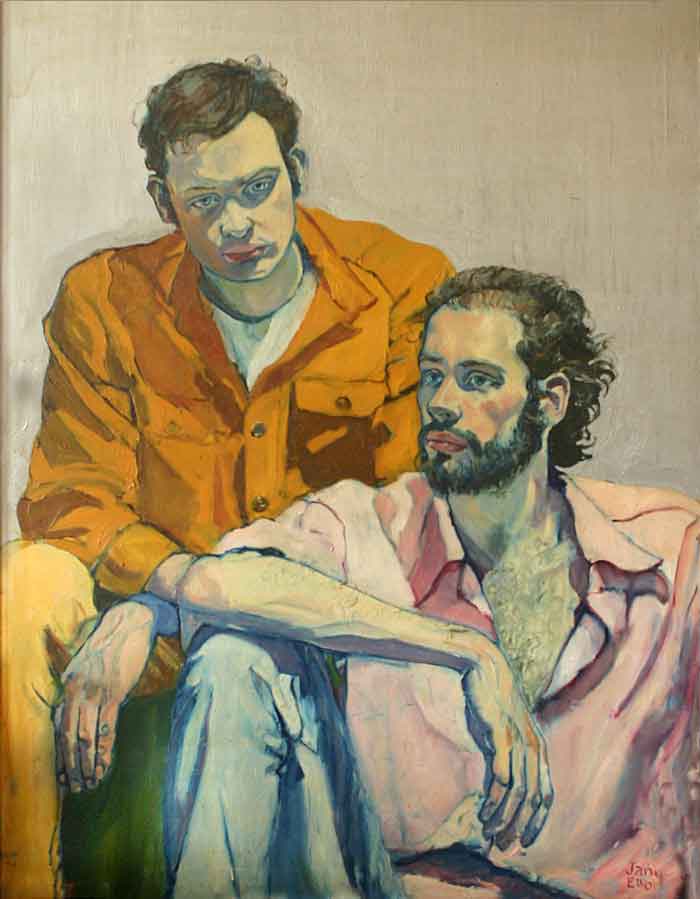 Twenty-Somethings George and Mike (left to right) in the Bronx, painted by the Canadian Jane Elford, one of their actresses. Art Jane EtlfordBut now with video—my class was making a science fiction picture and I needed a flying saucer to crash and explode into a building. I found out that right in the editing machine you can draw the flying saucer.
Twenty-Somethings George and Mike (left to right) in the Bronx, painted by the Canadian Jane Elford, one of their actresses. Art Jane EtlfordBut now with video—my class was making a science fiction picture and I needed a flying saucer to crash and explode into a building. I found out that right in the editing machine you can draw the flying saucer.
We had some footage of a volcano exploding (which we did by turning a fish tank upside down and using milk to look like a smoke plume), and I tilted the smoke in the computer so that it went diagonally across the screen, and I was able to animate that saucer.
How did you do the Cuban missiles in 'Night of the Bomb'?
It's like a Larry Jordan [an animator and teacher at SFAI]. Only instead of butterflies and hummingbirds you've got this mushroom cloud on oak tag. We drew on the atomic blast with crayons, single-framing that camera like an animated movie. Because we went to art school, we had this talent with drawing. My brother did that on his film, Sins of the Fleshapoids. He drew the castle, and he cut the window out on a piece of cardboard. He flashed a light behind the window to make it look like some kind of electrical machinery.
How did you develop your trademarked level of high camp?
My father kept those lurid pulp novels. The illustrations had good lighting, and the people looked kind of tortured, dramatic. I got inspiration from that visually and going to the movies - all of the European pictures: Fellini, Roger Vadim, Bridgette Bardot.
Thanks for taking time out of your morning to talk with us.
Yeah, it was my pleasure. Y'know, I was up until 5 am last night editing a picture.
Oh, really? What picture?
My brother and I made a diary of what happened in Las Vegas. We were on the red carpet because our picture played in the festival, and I was photographing all the photographers while they were taking pictures of us.
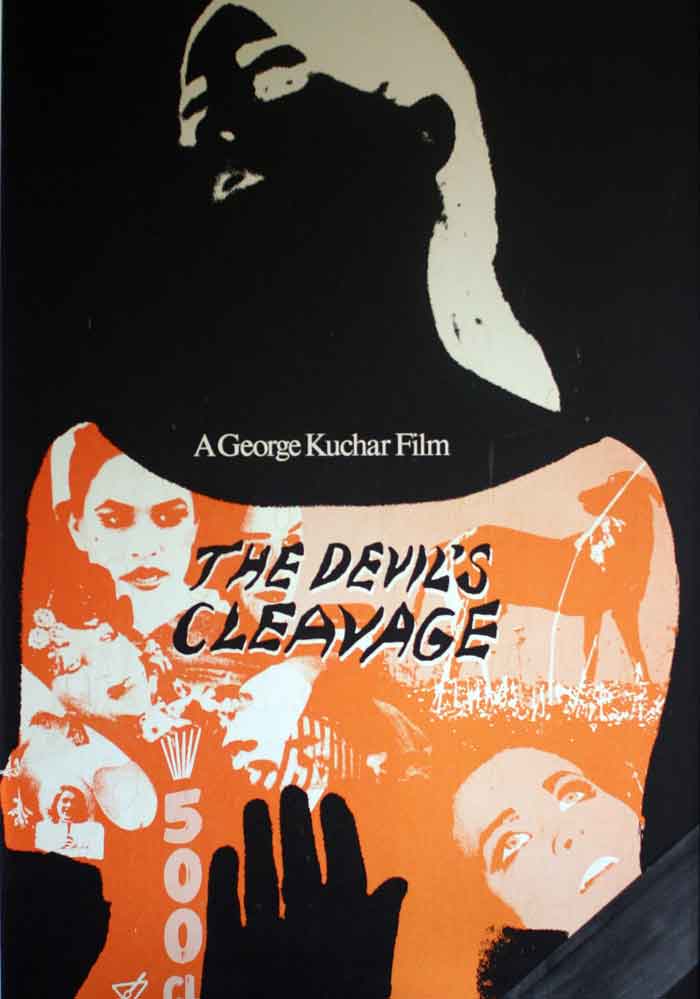 'The Devils Cleavage,' a 16mm feature by George about a big city nurse, Amesly Pryor (a painter at the Art Institute), and a host of other characters. art: unknown graphic designer in England As we left the Kuchar's Mission neighborhood railroad flat, jam-packed—but not cluttered—with rows of VHS tapes, art and photos, equipment and chotskies, we revelled in the delightful eccentricity of the two visionary film-poets. Even now, after 40 years of filmmaking, the Kuchars have retained the childlike curiosity which continues to drive them to make something out of nothing. The high camp aesthetic they pioneered became the artistic foundation for an entire generation of filmmakers - Waters, Warhol, Maddin, Lynch—as well as a cornerstore of postmodern gay culture.
'The Devils Cleavage,' a 16mm feature by George about a big city nurse, Amesly Pryor (a painter at the Art Institute), and a host of other characters. art: unknown graphic designer in England As we left the Kuchar's Mission neighborhood railroad flat, jam-packed—but not cluttered—with rows of VHS tapes, art and photos, equipment and chotskies, we revelled in the delightful eccentricity of the two visionary film-poets. Even now, after 40 years of filmmaking, the Kuchars have retained the childlike curiosity which continues to drive them to make something out of nothing. The high camp aesthetic they pioneered became the artistic foundation for an entire generation of filmmakers - Waters, Warhol, Maddin, Lynch—as well as a cornerstore of postmodern gay culture.
As he adjusted the lens one of his old Super8 cameras, George reminded me of the most important maxim of his career: "The only way your films will be made is if you make them yourself. You can try to sell your ideas, but sometimes people are too timid to commit. So if you're going to make a picture, you just do it with what you can work with."
Posted on Jul 13, 2009 - 06:46 PM
by Roger Rose
 The Kuchar Brothers at work in their crowded but not cluttered Mission neighborhood apartment. photo CineSource
The Kuchar Brothers at work in their crowded but not cluttered Mission neighborhood apartment. photo CineSourceAs the subjects of Jennifer Kroot's new feature documentary, "It Came From Kuchar," which opened at Frameline 33 here last month, the brothers are getting exposed to a much wider audience. Kroot is a former student of George Kuchar at the San Francisco Art Institute, where he still teaches, and which brought him to the Bay Area from the Bronx in 1971. Kroot knew from the very first day of class that she wanted to do a documentary on the legendary indie brothers. "As I got to know him and his brother, it kept unfolding in more interesting and strange ways. Eventually I just had to do it," she remarks.
The list of filmmakers citing the Kuchar brothers as influences continues on and on. From Wayne Wang to B. Ruby Rich and Atom Etoyan, generations of cineastes continue to borrow from their original style. "People see all of these filmmakers associated with them," said Kroot. "I think it's fair to say that they inspired John Waters to pick up a camera. Their style of filmmaking—using friends as actors, just having a good time with it—became essential to his work." Moreover, they focused on alternative narratives at a time when everyone was going visual and abstract.
The Kuchars established themselves as a part of the freethinking bohemian community in New York with George's "I Was a Teenage Rumpot" (1960), which made great use of what would become their infamous brand of homemade special effects. Their work slowly became known to artists, hitting a flash with a 1967 article in Playboy, in which writers Knight and Albert commented that, "the Kuchars take neither themselves nor their movies too seriously. For the most part the Underground is a dreadfully intense bunch of people."
Beginning with "The Secret of Wendel Samson," Mike's films became socially relevant as openly sexual portrayals of the then-taboo gay lifestyle. In this film, avant-garde artist Red Grooms played a conflicted young man torn between unfulfilling gay and straight relationships. "Sins of the Fleshapoids" helped to launch a lasting ouvre of high-camp cinema (see it here).
Since 1963, the Kuchar's 200+ films have delighted audiences on the fringe of the commercial world—and they have even won several coveted awards (AFI, Maya Deren Independent Film and Video Artists Award, 1992; Los Angeles Film Critics Award, Independent/Experimental Film Award, 1984; NY Lesbian and Gay Film Festival, Peter S. Reed Achievement Award, 1999). Most recently they received the prestigious Frameline Award, which honors an artist who has made a major contribution to LGBT representation in the media.
We sat down with the tall, lanky Kuchar Brothers in their full-but-not-cluttered Mission-neighborhood flat to take some shots and reflect upon a lifetime of work that has influenced indie film as we know it today. We spoke with Mike first, while George edited footage he had taken from his recent trip to the CineVegas Film Festival.
CineSource: Your work spans a lifetime. Why don't you tell me a little bit about your childhood in the Bronx.
Mike Kuchar: As a kid, I always loved to go to movie theaters. It was kind of a technical education for me. We started to mimic it with an 8mm camera that we got for our 12th birthday. It was sort of a natural kind of evolution that we started to reproduce what we saw in these movie theaters.
What were some ways you used your new camera?
We would set up dramatic spectacles. We took down our mother's draperies from the window; we'd use them as costumes in these biblical and fantastic productions. We got our friends and family to star in our little productions, and worked in 8mm before Super8. When Super8 came in, all it did was shrink the sprocket holes down on 8mm.
It seems like when you guys started, even as kids, that you were doing this narrative thing that other people weren't.
Well, when we started, everyone was shooting with a home-movie camera. Most people were recording their vacations, their relatives, birthday parties. But my brother and I were concocting little dramas to tell stories in the Bronx. We'd make little dramas, manipulating the medium to what was normally done with industry equipment.
Tell me, George: at such an early age, how did you formulate a way of looking at movies?
George Kuchar: The Hitchcock movies were amazing to look at for the editing. You realized what the characters were thinking, psychologically, by the way he would cut to them. Little glances. It was all about the editing in those films, so that was good schooling for editing.
It was great watching Roger Corman movies, because they were so funny and slapdash that you realized that you didn't have to be strict and fine-tune that stuff. The gimmicks they were getting away with looked like fun; it looked like you could just be a kid. It made you feel like you didn't have to be a grown-up in a straight jacket.
You and Mike earned a reputation as the first to use low-budget or no-budget materials. Can you tell me about a couple scenes or films where you got away with the low-budget, no-budget stuff?
George: The whole thing was no budget, 'cause we didn't make much money. I made $68, maybe $70 a week. Film was so much cheaper in the 60s when I was making these 16mm movies, and I managed to get grant money. Even then I still made the cheapo special effects in my bedroom.
I had been making videos before, and I didn't have a video editing machine where you could do special effects, so I was doing it all in the camera, which meant that there were no dissolves. The only super-impositions you could get were from the reflections on the glass in storefront windows. I realized how important film was, because you can put the film back in the camera and record over it for a superimposition.
So for this big sci-fi film, I did all the effects in my bedroom. I bought dolls and dyed them for robots, and then made my flying saucer out of paper and stuck it on a sheet of glass. I would superimpose by putting the film back in the Bolex camera, winding back, and I made little notes about where to stop and start.
I thought, 'This is funny, you get your money's worth just by putting the film back in the camera and shooting layers.' So that dictated the style of the film at that time. It had big montages. Everything was done in-camera.
Nobody was there except me and the little dolls. The picture was actually taken seriously in Europe -- it was called 'Ascension of the Demonoids.' It was part of my flying saucer series. In the States, the papers used words like 'special effects' and 'Planet Nine from Outer Space.'
 Twenty-Somethings George and Mike (left to right) in the Bronx, painted by the Canadian Jane Elford, one of their actresses. Art Jane Etlford
Twenty-Somethings George and Mike (left to right) in the Bronx, painted by the Canadian Jane Elford, one of their actresses. Art Jane EtlfordWe had some footage of a volcano exploding (which we did by turning a fish tank upside down and using milk to look like a smoke plume), and I tilted the smoke in the computer so that it went diagonally across the screen, and I was able to animate that saucer.
How did you do the Cuban missiles in 'Night of the Bomb'?
It's like a Larry Jordan [an animator and teacher at SFAI]. Only instead of butterflies and hummingbirds you've got this mushroom cloud on oak tag. We drew on the atomic blast with crayons, single-framing that camera like an animated movie. Because we went to art school, we had this talent with drawing. My brother did that on his film, Sins of the Fleshapoids. He drew the castle, and he cut the window out on a piece of cardboard. He flashed a light behind the window to make it look like some kind of electrical machinery.
How did you develop your trademarked level of high camp?
My father kept those lurid pulp novels. The illustrations had good lighting, and the people looked kind of tortured, dramatic. I got inspiration from that visually and going to the movies - all of the European pictures: Fellini, Roger Vadim, Bridgette Bardot.
Thanks for taking time out of your morning to talk with us.
Yeah, it was my pleasure. Y'know, I was up until 5 am last night editing a picture.
Oh, really? What picture?
My brother and I made a diary of what happened in Las Vegas. We were on the red carpet because our picture played in the festival, and I was photographing all the photographers while they were taking pictures of us.
 'The Devils Cleavage,' a 16mm feature by George about a big city nurse, Amesly Pryor (a painter at the Art Institute), and a host of other characters. art: unknown graphic designer in England
'The Devils Cleavage,' a 16mm feature by George about a big city nurse, Amesly Pryor (a painter at the Art Institute), and a host of other characters. art: unknown graphic designer in England As he adjusted the lens one of his old Super8 cameras, George reminded me of the most important maxim of his career: "The only way your films will be made is if you make them yourself. You can try to sell your ideas, but sometimes people are too timid to commit. So if you're going to make a picture, you just do it with what you can work with."
Posted on Jul 13, 2009 - 06:46 PM














